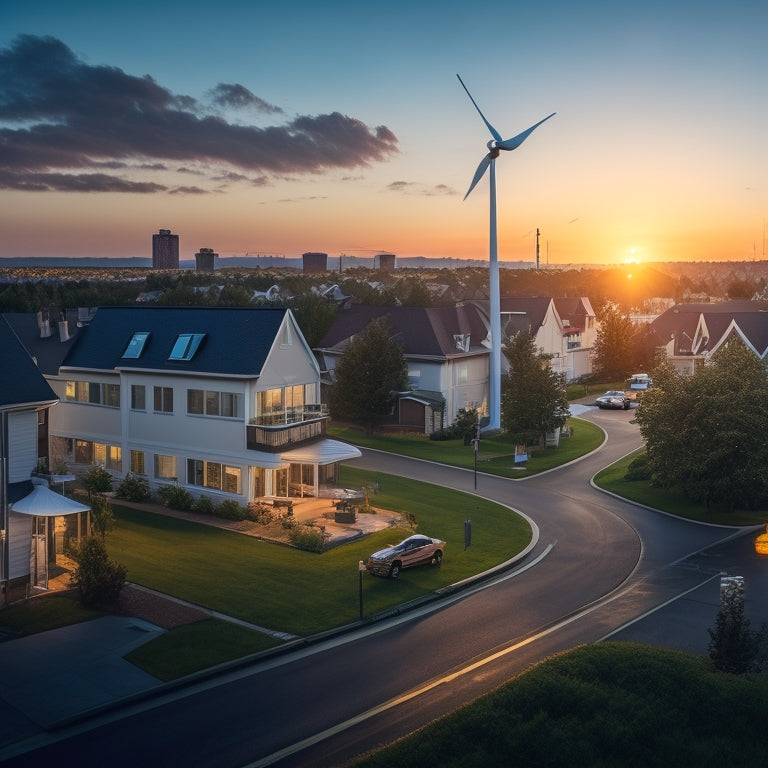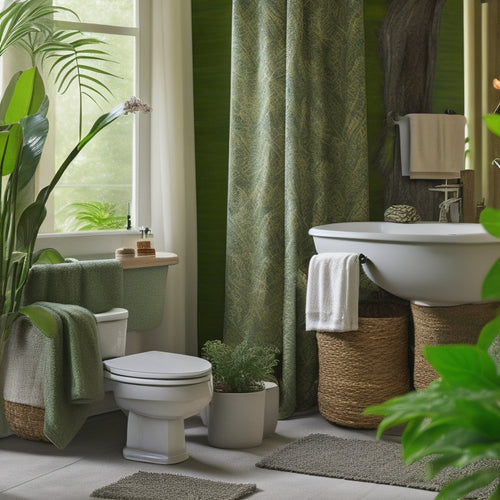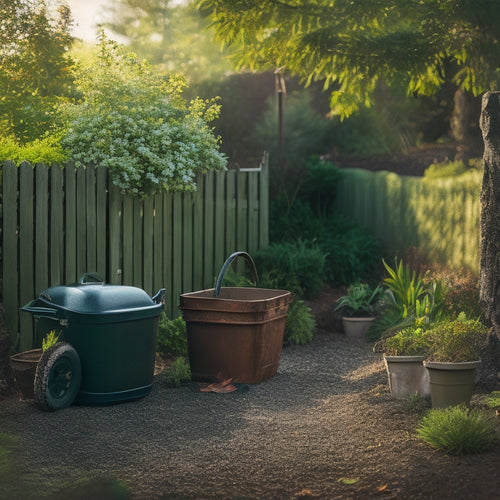
Residential Wind Turbines: Safety Measures for Urban Areas
Share
As you consider installing a residential wind turbine in an urban area, you'll need to prioritize safety measures to minimize risks and guarantee smooth operation amidst densely populated surroundings. Turbine placement, noise reduction strategies, and electrical safety precautions are essential, as is containment of potential blade failures. Emergency shutdown procedures and regular maintenance requirements must also be put in place. You'll need to comply with local regulations and electrical codes, while also monitoring turbine performance and identifying faults. By following these guidelines, you'll be well on your way to a safe and efficient urban wind turbine installation - and there's still more to uncover.
Key Takeaways
- Turbine placement evaluation considers wind direction, speed, and turbulence patterns to ensure safe and efficient operation in urban areas.
- Sound barriers, acoustic screens, and natural barriers minimize noise pollution from residential wind turbines, complying with local noise regulations.
- Electrical safety measures include surge protection devices, grounding systems, and regular inspections to prevent shocks and faults in urban installations.
- Regular monitoring and maintenance are crucial to detect potential issues, prevent blade failures, and ensure safe operation in urban environments.
- Automated shutdown procedures, emergency cut-off switches, and alert systems help mitigate risks and ensure safe operation of residential wind turbines in urban areas.
Turbine Placement and Proximity
Your turbine's placement and proximity to your property's features are vital factors in determining its efficiency and overall performance.
You'll need to take into account turbine zoning regulations, which vary by region, to guarantee your installation complies with local authorities. In urban areas, regulations often dictate minimum distance requirements from property lines, roads, and neighboring buildings to mitigate visual impact and potential noise disturbance.
Proper placement also involves evaluating wind direction, speed, and turbulence patterns to optimize energy production.
Additionally, it's significant to evaluate the compatibility of wind turbines with other renewable energy solutions to create an all-encompassing sustainable energy strategy. By analyzing the feasibility of hybrid electric solutions and energy storage systems, you can create a more efficient and resilient energy system.
Noise Reduction Strategies
You'll find that sound barriers can be an effective way to minimize the noise generated by your residential wind turbine, as they absorb or deflect sound waves.
Additionally, optimizing solar panel array design energy-efficient solutions can also play a role in reducing overall energy costs, making your wind turbine a more feasible option.
Quiet turbine designs, which incorporate features like slower rotor speeds and specially shaped blades, can also reduce noise pollution.
Sound Barriers Work
Sound barriers are a simple yet effective noise reduction strategy for residential wind turbines. They can be installed around the turbine or along nearby buildings to block or absorb sound waves, reducing the noise impact on nearby residents.
Regular maintenance, including cleaning and inspecting connections, is essential for optimizing performance and ensuring longevity, as seen in solar panel maintenance. This is especially important for urban areas where noise reduction is vital.
You can implement sound barriers in various ways, such as:
- Installing acoustic screens or walls around the turbine
- Using sound-insulating materials for building construction
- Creating natural sound barriers like trees or hills
- Incorporating sound-absorbing materials into urban planning designs
Quiet Turbine Designs
Beyond noise reduction through sound barriers, optimizing turbine design itself can also play a significant role in minimizing disturbance. You can investigate various quiet turbine designs that prioritize noise reduction strategies.
One approach is to focus on turbine aesthetics, ensuring that the visual appeal of the turbine doesn't compromise its functionality. For instance, sleeker blade designs can reduce noise levels while maintaining energy efficiency.
Additionally, urban integration can be achieved by designing turbines that blend seamlessly with urban environments, reducing visual impact and noise pollution. With the integration of solar canopy solutions in urban planning, wind turbines can be designed to maximize energy production while minimizing physical footprint.
Electrical Safety Precautions
Three vital electrical safety precautions must be observed when installing and operating residential wind turbines. You must guarantee that your turbine is designed and installed with safety in mind to prevent electrical shocks, fires, and other hazards.
Additionally, it's imperative to reflect on the installation costs of commercial EV charging stations, which can range from $500 to $50,000+, including solar-powered systems that can provide significant energy savings.
Furthermore, regular maintenance, including cleaning and preventive measures, is essential for the long-term performance and lifespan of electrical systems.
- Install a grounding system that meets local electrical codes and standards to prevent electrical shocks.
- Use surge protection devices to protect your turbine and electrical infrastructure from power surges and lightning strikes.
- Confirm that all electrical components are rated for outdoor use and can withstand the elements.
- Regularly inspect and maintain your turbine's electrical system to prevent faults and malfunctions.
Blade Failure Containment
When installing a residential wind turbine, you're dealing with massive, rotating blades that can be catastrophic if they fail. To mitigate this risk, it's essential to focus on blade failure containment.
You should select blades made from durable materials that can withstand extreme wind speeds and harsh environmental conditions. The turbine's design should also consider wind speed considerations, guaranteeing that the blades are engineered to operate within a specific speed range.
Additionally, the turbine's foundation and tower should be designed to absorb or redirect the force of a potential blade failure, preventing damage to surrounding structures or harm to people.
Emergency Shutdown Procedures
You should guarantee that your residential wind turbine has emergency shutdown procedures in place to minimize risks and damages in case of unexpected events.
These procedures typically include remote shutdown capabilities that allow you to shut down the turbine quickly from a distance.
Additionally, automatic fault detection systems can identify potential issues and initiate shutdown protocols to prevent further damage or safety hazards.
Shutdown Protocols in Place
Emergency situations can arise unexpectedly, and having shutdown protocols in place is essential to guarantee the safe operation of residential wind turbines.
You need to verify that your turbine is equipped with reliable shutdown mechanisms to prevent accidents and comply with urban regulations. This is imperative to maintain peak turbine performance and avoid potential hazards.
Some important shutdown protocols to take into account include:
- Automatic cut-off switches that respond to excessive wind speeds or unusual vibrations
- Manual shutdown buttons accessible to authorized personnel
- Regular maintenance schedules to detect and address potential issues before they escalate
- Alert systems that notify you of unusual turbine behavior or performance anomalies
Remote Shutdown Capabilities
Implementing remote shutdown capabilities in residential wind turbines allows for swift intervention in emergency situations, ensuring that turbines can be safely powered down from a distance in response to unforeseen events or anomalies.
You can rest assured that with remote monitoring, you'll receive automated alerts in real-time, enabling you to respond promptly to potential issues.
This feature grants you the freedom to take control of your turbine's operation from a remote location, ensuring your safety and the safety of those around you.
In the event of an emergency, you can initiate a shutdown procedure with ease, minimizing risks and potential damages.
This capability provides an added layer of security, giving you peace of mind and confidence in your residential wind turbine.
Automatic Fault Detection
The self-diagnostic system of residential wind turbines is equipped with advanced sensors that continuously monitor turbine performance, enabling swift detection of anomalies and faults. This allows you to take prompt action in case of an emergency.
The system's predictive analytics capabilities help identify potential issues before they become major problems.
In the event of a fault, the turbine can automatically shut down to prevent damage or injury.
Some key features of this system include:
- Real-time monitoring of turbine performance data
- Advanced sensor technology for accurate fault detection
- Automated alerts and notifications for prompt action
- Integration with emergency shutdown procedures for maximum safety
Regular Maintenance Requirements
Performing routine checks on your residential wind turbine is essential to assure peak performance, extend its lifespan, and prevent costly repairs.
You'll need to establish a maintenance schedule that includes regular inspections of the turbine's blades, hub, and tower. Check for signs of wear, corrosion, or damage, and replace components as needed.
Additionally, ascertain that the turbine's electrical connections are secure and functioning properly.
Frequently Asked Questions
Are Residential Wind Turbines Covered Under Homeowner's Insurance Policies?
You'll typically find that homeowner's insurance policies cover residential wind turbines, but you'll need to review your policy's exclusions and limitations to verify you're protected; don't assume coverage without confirming your insurance coverage and policy details.
Can Wind Turbines Be Installed on Rented Properties?
You'll need to check your rental agreement and local installation regulations before installing a wind turbine on rented properties, as some landlords or municipalities may have specific restrictions or requirements for renewable energy systems.
How Do Wind Turbines Affect Property Values in Urban Areas?
When you're on the fence about urban wind energy, consider this: your property value perceptions might take a hit, as nearby turbines can be an eyesore, but they can also increase appeal, making your home a hot commodity.
Are There Any Incentives for Installing Residential Wind Turbines?
You can take advantage of federal tax incentives, such as the Renewable Energy Credit, and state rebates, like the California Solar Initiative, to offset the cost of installing residential wind turbines, increasing your energy independence and savings.
Can Wind Turbines Be Installed on Rooftops or Only in Yards?
As you stand on the rooftop, feeling the wind's gentle caress, you wonder: can turbines join the view? Yes, you can install them on rooftops, but urban regulations will dictate feasibility, so research local codes before taking the leap to capture the breeze.
Related Posts
-

Sustainable Scrubbing: Top Bathroom Solutions for Earth-Conscious Homes
You're taking an important step towards creating a more sustainable home by switching to eco-friendly bathroom cleani...
-

3 Best Solar-Powered Biodegradable Accessories for Your Home
You're taking a significant step towards a more sustainable lifestyle by incorporating solar-powered biodegradable ac...
-

10 Green Waste Solutions Every Homeowner Should Know
You can make a significant impact on the environment by implementing green waste solutions at home. Consider composti...


